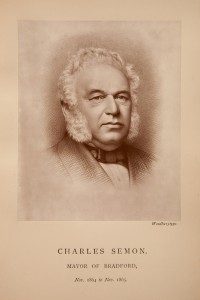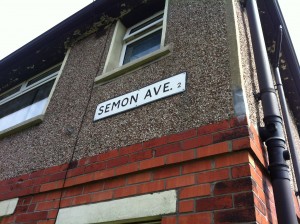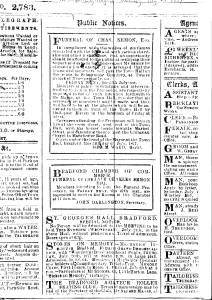The first Bradford Jewish Merchant to enter into local politics was Danzig born textile exporter Charles Joseph Semon. He was born in the German port in 1814 and arrived in Bradford in during middle age, right in the middle of the 19th Century. By 1864 he had become Lord Mayor and led a number of benevolent schemes during his time in civic and commercial life.
He had his offices and warehouse at 25 Bolton Road. In 1851 along with Jacob Behrens and Leopold Fulda, he helped to found the Bradford Chamber of Commerce, becoming it’s vice president some 20 years later.
In 1874 he established a convalescent home, now demolished in Ilkley, which was named in his honour. He gave it to the then equivalent of the town council, the Bradford Corporation. Generously he also granted a hefty bequest for its upkeep.
By the time of his death in 1877 he had let the people of Bradford benefit enormously from his own personal wealth. Even after death his generosity continued, as he left £35,000 in his will for Bradford’s educational institutions to benefit from, the equivalent of £3,347,730 in today’s money.
He died whilst on holiday in Switzerland, his health had been deteriorating since at least the January of 1877 according to Rev Dr. Lowry a rabbi of London.
There is a street named after Charles Semon which is on the Swain House Estate in North Bradford, which was built between the wars, Semon Avenue.
Below follows an account of the Funeral held for him in Bradford town centre, as reported in the day by the Bradford Daily Telegraph, Wednesday July 25 1877.
________________________________________________________________________________
The Bradford Daily Telegraph, Wednesday July 25 1877
________________________________________________________________________________
Public Notices.
________________________________________________________________________________
FUNERAL OF THE LATE CHARLES SEMON .
The interment of the remains of the late Charles Semon took place to-day in Scholemoor Cemetery, where ground for a burial place for Jews was some-time ago appropriated. The coffin containing the remains, which, after being brought from Switzerland, had been enclosed in a finely finished oak coffin by Messrs. C. Pratt and Sons, who had charge of the funeral arrangements, was last night transferred from the Town hall, where it was joined by the various public bodies, the members of the Council and others. The streets along the route were lined by the populace who gathered so thickly in Market Street that it was impossible to pass along. A detachment of police kept the way open for the passage of the procession, which arrived a few minutes after twelve, and after being joined by the representatives of the various public bodies, and houses who had assembled there, it proceeded on the way to Scholemoor. During the time the cortège was passing the bell was tolled, and afterwards the chimes played Mendelssohn’s “O Rest in the Lord”. A description of the proceedings will appear in our second edition.
Funeral of the late Charles Semon.
Bradford has to-day deservedly accorded a public funeral to the remains of one of the worthiest of her citizens. There was not the long connection and the deep and wide-spread personal feeling that made the last public funeral one of those imposing spectacles only witnessed on rare occasions. Still, if on a smaller scale, the ceremony of to-day partook fully of the same character, and was an honourable tribute to the genuine work of the deceased, a testimony to the esteem the deceased had won for himself from all classes of the community by his unostentatious, liberality, generous support of all our public benevolent institutions, his readiness to respond to all appeals for help from whatever quarter once they proved themselves as deserving, his upright and consistent conduct as a man of business, and his assiduous endeavours in a whole variety of ways to discharge to the utmost of his ability the duties falling upon him as one of the foremost citizens of Bradford. He did not labour without reward, and the numerous and influential gathering of those who had been his fellow burgessers who to-day assembled to follow his remains to the grave showed how cordially his conduct had been appreciated.
The remains of the deceased, which were brought from Switzerland in a varnished deak (sic) shell of rather peculiar form, were at first taken to the Town Hall and there the shell was enclosed in an oak coffin supplied by Messrs Pratt and Son, to whom the charge of the funeral arrangements were entrusted . This was last night removed to the residence of Mr Lassen, Rosemount, Clifton Villas, where the relatives and immediate friends of the deceased assembled this morning, and the funeral procession was formed, consisting of twenty private carriages.
Meanwhile in the town Market Street, along by the Town Hall, and Horton Road had been gradually filled with a dense crowd, who filled the footway to completely that passers by found it necessary to seek other ways of getting to their destination. All along the route the shutters of the shops, warehouses & c (sic) were all closed, which, with the stoppings or diversion of foot and vehicular traffic, gave an unwouted quietness to the locality. In the vicinity of the Town Hall
place was there a little stir, as the fast swelling crowd of mourners who intended to join in the procession came up and ranged themselves in one or other of the many companies into which the procession was divided. The turn-out was very large, comprising representatives of all the leading mercsntile establishments in the borough, of the various societies, charitiable and benevolent, with which the deceased had been connected, &c. Amongst those who assembled in the mayor’s parlour were the following:- William Foster, Henry Mason, Mr Thompson, Duggan, Binns, J. Wright, junior, Stockdale, Blackburn, Wilson, Sutcliffe, Mr. Brayshaw and Mr. Barker, of the Board of Guardians, &c.
The funeral processon was to start at 12 o’clock, and shortly before that time the procession was formed and took up its position along Market Street and Horton Road, in readiness for the arrival of the hearse with its followers from Rosemount. The great bell was tolling slowly as it appeared, and taking its appointed station the cortege, ranged in the following order:-
Employees of Messrs. Semon and Co.
Employees of Messrs. Siltzer and Co.
Chamber of Commerce.
Board of Guardians.
Bradford Infirmary.
Eye and Ear Hospital.
Fever Hospital.
Nurses’ Training Institution.
Royal National Lifeboat Institution.
Tradesmen’s Benevolent Institution.
Tradesmen Home.
Spinsters Provident Fund.
Society for the Prevention of Cruelty to Animals.
Mechanics Institute.
Friends.
Church Institute.
Grand Order of Oddfellows.
Borough Magistrates
The Mayor and Corporation (preceded by the Mace Bearer and Corporate Officers).
THE HEARSE.
Members of the Jewish Assosication
Private Carriages
Amongst these were those of Mr Semon; Mr Lassens; the Mayor (Ald. Waud); Ald Mitchell; Mr Lewis, Claremont; George Hodgson, Legrams; William Mossman, Woodhall; Mr Nathan; Mr Glyde;Mr Sichel; Mr Joseph wade; Mr George Firth, Ashfield; Mrs Calvert, Manningham; Mr Henry Illingworth; Mr Angus Holden; Mr Simon Israel; Mr James Lund, Crosshills; Mr George Turner, Legrams; Mr Robert Kell; Mr Alfred Priestman, Dr Bronner; Mr T. Sheilds; Mr James Tankard, Bowling Hall; Mr Joseph Craven, Thornton; Ald Law, Bolton Hall; Mr Eli Mills; Mr M.W. Thompson, Guiseley; Mr F. Anderton, Bolton Royd; Mr B.S. Ward, Lightcliffe; Mr J.R. Armitage, Shipley; and about thirty others, Amongst the representatives of the various Institutions were Messrs. J Rhodes, J. Beanland, Councillor Armitage, Geo. Knowles, Robt Sutcliffe and Thos. Stephenson for the Infirmary; Drs Dunlop, Goyder, and Brown, anb Mr. Pesel for the Nurses’ Institution; Mr J.A. Godwin and Mr J.M. Jowett, the National Lifeboat; the Revs. Knight Gale, C. Edwards, Messrs J. Broadbent, J.P. Muff, B. Broughton, and M. Eastwood, the Fever Hospital; Mr C. Behrens and J. Ambler of the Eye and Ear Hospital; Mr Philip Grant of Manchester and Mathew Balme, Bradford represented the promotors and supporters of the factory legislation in the North of England. The list of the chamber of Commerce, merchants, &c., woiuld comprise most of the leading names in the borough an district.
Upon leaving the Town Hall, the procession proceeded at a moderate pace towards its destination, the Scholemoor Cemetery, where the remains of the deceased were to be consigned to their last resting place. From Market Street the mournful cortège wended its way along the Great Horton Road. Both sides of the road were thickly thronged with spectators, and from these walls, windows &c, others endeavoured to catch a glimpse of the mourners. From Great Horton Road, the procession passed into Shearbridge and at Legrams Lane there was also a numerous assembly, and the police experienced great difficulty in maintaining command over the road. Legrams Road was for some distance almost free from spectators, but the number of pedestrians all en route for the Cemetery was very great. The wind being somewhat disagreeable in consequence of the clouds of dust that were raised. At the top of Legrams Road, and from thence to the Cemetery, some thousands of persons had concentrated. Walls, windows, occasionally house tops, and every other available place were utilised, and great care was experienced by the police in keeping the roads clear for the procession.
The Jewish enclosure of the cemetery was surrounded on all sides by a crowd anxious to have a view of the funeral ceremony. This curiosity was evidently excited from the fact that with the exception of an interment about a month ago, nobody had been previously buried there. There was little, however, to gratify the curious, for the ceremony was simple in character, and to observers differed little from the funeral of Christians. The first thing at all novel that was observable on entering the ground was a small table, with a white cover, placed near the entrance gate and upon it was a small box bearing the inscription, “Remember the Poor”, intended to receive the contributions of the benevolently disposed. The work people present at the funeral were first to enter the enclosure, and immediately after them came the members of the Jewish Association. Then came the Mayor, Town Clerk, and members of the Corporation. Immediately following the coffin were the two brothers in-law of the deceased, who are officers of the Bavarian Army.and as they wore the attractive blue uniform and helmets of that force, they were the centre of much curiosity. Among the chief mourners were Dr. Julius Semon, brother of the deceased; the nephew of the deceased, Mr E.S. Lassen, &c.
The coffin was borne into the cemetery on the shoulders of a dozen bearers. It was of polished oak, of peculiar shape, in conformity with the construction of the slighter ones which it enclosed. It was placed near the grave, and the Rev. Dr. Lowry, rabbi, London (who wore the black gown and head-dress of his order), proceeded to read prayers. Up to this time the work people at the funeral had formed a square at a slight distance near the grave, as directed by Supt. Laycock, who had charge of the grounds; but, as soon as the rabbi began to read prayers, they hurried round the coffin and thus obstructed the sight and hearing of the rest. They prayers did no occupy very long, and as soon as they were over the Mayor and cheif mourners placed wreaths of flowers upon the coffin, the lid of which was entirely covered with them before the body was lowered into its resting place. The vault was walled with brick, and was about six feet in depth. As the coffin was lowered the Rev. Dr. Lowry, read the portion of Scripture, beginning “Man that is born of a woman, &c.” and after another prayer delivered a short address- He said he wished to offer a tribute of sympathy to the living to the living wife who was now plunged in mourning, and a word of sympathy with those who felt that the useful works performed by Charles Semon were now likewise bereaved. The widow, passing from a state of happy marriage to a state of widowhood, had to go through a valley of weeping; and he wished to offer on behalf of that assembly a tribute of public sympathy for one whom a merciful hand had released had released from its agony. There was left behind consoling reflections and the parted would stand before her crowned with Heavens blessings. What was the foundation on which Chas Semon rested his unsullied and respected name? His impressions were derived from his father’s house; it was there his noble principles were cultivated. In the house of his father Charles Semon was told there was one lesson which the Israelites had brought down for thousands of years- a lesson which rose from the grave and appealed to the survivors- “Men be merciful to each other, be charitable to each other; and be wisely charitable and wisely merciful.” he wished to say a word which came from Charles Semon. In January last the deceased said to him “In July I hope to come back with my strength recruited, and I shall then devote myself to philanthropic work, which I have begun to interest myself in among my fellow Israelites in Bradford.”.
After the address Dr. Lowry uttered a short prayer, and then threw a shovelful of earth upon the coffin. The chief mourners did the same, after which more wreaths of flowers were thrown into the grave.
This terminated the funeral obsequies.
Thanks and Credits go the Local Studies Department of Bradford Central Library for the information which is available on Microfilm.



